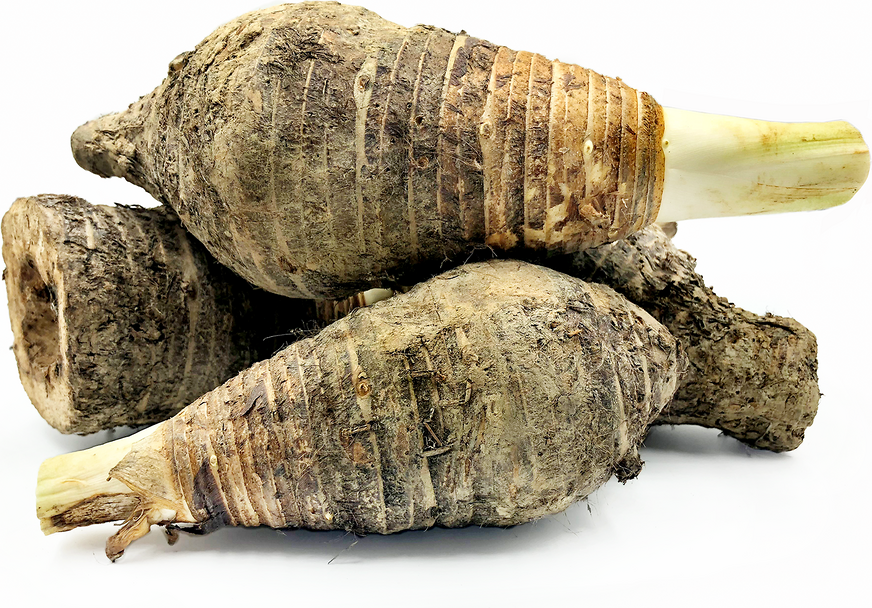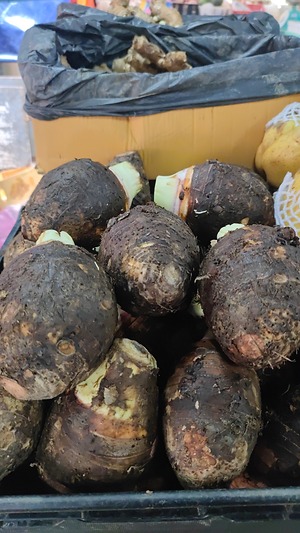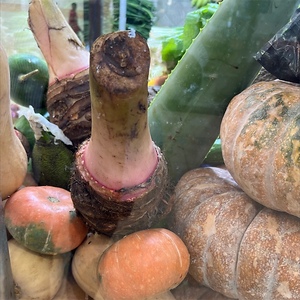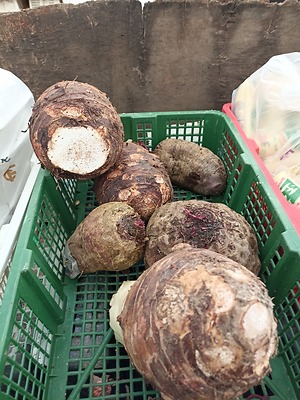


Keladi Root
Estimated Inventory, lb : 0
Description/Taste
Keladi ranges from small to large in size, averaging 8-10 centimeters in diameter and 16-28 centimeters in length, and has an oblong, cylindrical, and elongated shape with one bulbous end slightly tapering to a point. The rough, uneven skin can be smooth or hairy, depending on the variety, and bears a mixture of brown and white hues with prominent growth rings. Underneath the surface, the flesh is firm, moist, dense, and white or cream-colored with purple spots and specks. When cooked, Keladi is starchy with a mild, sweet, and slightly nutty taste.
Seasons/Availability
Keladi is available year-round.
Current Facts
Keladi, botanically classified as Colocasia esculenta, is a swollen, underground root known as a corm and is a member of the Araceae family. Commonly found in tropical and sub-tropical climates, Keladi is one of the few crops that grow well in wet, flooded regions and is predominately cultivated across Southeast Asia, India, and New Guinea. Keladi is known by many different names including Taro, Dasheen, Kalo, and Eddoe, and over thirty different varieties have been found growing in cultivation and the wild. Keladi is used as a vegetable in culinary preparations and must be cooked before consumption as it contains toxic calcium oxalate, which acts like tiny pieces of glass, irritating the mouth and throat. This irritant is removed when the tuber is cooked.
Nutritional Value
Keladi contains very high amounts of vitamin C, which makes the corm a good source of antioxidants to help support the immune system. It also contains vitamins A, E, and B6, iron fiber, potassium, copper, magnesium, and calcium.
Applications
Keladi is poisonous when raw and must be cooked to remove the irritating calcium oxalate in applications such as boiling, steaming, and frying. It can be sliced, boiled, and served in coconut milk, spiralized and sautéed to make noodles, shredded and fried to make crispy pancakes, or sliced and baked as chips. In addition to savory dishes, Keladi is also used in sweet dishes such as pumpkin buns, cakes, pies, bubble tea, and ice cream. Keladi pairs well with meats such as duck and pork belly, shrimp, rice, pea shoots, green onion, shallots, chilies, coconut, sugar, and tomato. The corm will keep for a few days when stored in a paper bag at room temperature in a cool and dry place.
Ethnic/Cultural Info
Keladi is a common kitchen ingredient in Thailand, Malaysia, and India, and has a revered status in Hawaii. The leaves, stems, and corms are all used in traditional cooking and in Hawaii, it is eaten principally as poi which is prepared by mashing the cooked root and creating a paste, that is either fermented or served immediately, typically with salted fish. Keladi is also grown for lu'au, which in Hawaii is the term used for both the cooked leaves and the Hawaiian feast. In the Philippines, Keladi has grown in importance because it is a reliable crop that can be used in place of other vegetables when food shortages arise. Keladi is commonly used in the Filipino national stew known as sinigang, where it is used as a thickener. It is also incorporated into laing, which is a dish that cooks Keladi leaves in coconut milk and is salted with fermented shrimp.
Geography/History
Keladi is native to Southeast Asia and along with malanga or yautia may be one of the very first known cultivated vegetables. Its use dates back to ancient times, having been described as an important crop by both Greek and Roman historians. The root then spread to tropical regions around the globe by explorers and traveled west to Egypt and Africa and east to the Pacific Islands. Today Keladi is widely cultivated around the world and can be found in local markets and specialty grocers in Asia, the Philippines, Indonesia, Malaysia, the United States, the Caribbean, and tropical Africa.
Recipe Ideas
Recipes that include Keladi Root. One
| Huang Kitchen |
|
Steamed Yam Cake |










